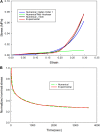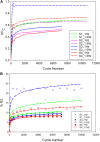Stress-Relaxation and Cyclic Behavior of Human Carotid Plaque Tissue
- PMID: 32117939
- PMCID: PMC7026010
- DOI: 10.3389/fbioe.2020.00060
Stress-Relaxation and Cyclic Behavior of Human Carotid Plaque Tissue
Abstract
Atherosclerotic plaque rupture is a catastrophic event that contributes to mortality and long-term disability. A better understanding of the plaque mechanical behavior is essential for the identification of vulnerable plaques pre-rupture. Plaque is subjected to a natural dynamic mechanical environment under hemodynamic loading. Therefore, it is important to understand the mechanical response of plaque tissue under cyclic loading conditions. Moreover, experimental data of such mechanical properties are fundamental for more clinically relevant biomechanical modeling and numerical simulations for risk stratification. This study aims to experimentally and numerically characterize the stress-relaxation and cyclic mechanical behavior of carotid plaque tissue. Instron microtester equipped with a custom-developed setup was used for the experiments. Carotid plaque samples excised at endarterectomy were subjected to uniaxial tensile, stress-relaxation, and cyclic loading protocols. Thirty percent of the underlying load level obtained from the uniaxial tensile test results was used to determine the change in mechanical properties of the tissue over time under a controlled testing environment (Control tests). The stress-relaxation test data was used to calibrate the hyperelastic (neo-Hookean, Ogden, Yeoh) and linear viscoelastic (Prony series) material parameters. The normalized relaxation force increased initially and slowly stabilized toward the end of relaxation phase, highlighting the viscoelastic behavior. During the cyclic tests, there was a decrease in the peak force as a function of the cycle number indicating mechanical distension due to repeated loading that varied with different frequencies. The material also accumulated residual deformation, which increased with the cycle number. This trend showed softening behavior of the samples. The results of this preliminary study provide an enhanced understanding of in vivo stress-relaxation and cyclic behavior of the human atherosclerotic plaque tissue.
Keywords: carotid plaque; cyclic test; mechanical behavior; stress-relaxation test; tensile test.
Copyright © 2020 Paritala, Yarlagadda, Kansky, Wang, Mendieta, Gu, McGahan, Lloyd and Li.
Figures











Similar articles
-
The effects of cyclic tensile and stress-relaxation tests on porcine skin.J Mech Behav Biomed Mater. 2018 Jan;77:242-249. doi: 10.1016/j.jmbbm.2017.09.009. Epub 2017 Sep 11. J Mech Behav Biomed Mater. 2018. PMID: 28954243
-
Mechanical behavior of calcified plaques: a summary of compression and stress-relaxation experiments.Z Kardiol. 2000;89 Suppl 2:85-91. doi: 10.1007/s003920070105. Z Kardiol. 2000. PMID: 10769409
-
Characterization of fracture behavior of human atherosclerotic fibrous caps using a miniature single edge notched tensile test.Acta Biomater. 2016 Oct 1;43:101-111. doi: 10.1016/j.actbio.2016.07.027. Epub 2016 Jul 16. Acta Biomater. 2016. PMID: 27431877 Free PMC article.
-
Mechanical properties of human atherosclerotic intima tissue.J Biomech. 2014 Mar 3;47(4):773-83. doi: 10.1016/j.jbiomech.2014.01.019. Epub 2014 Jan 14. J Biomech. 2014. PMID: 24529360 Review.
-
Review: Mechanical Characterization of Carotid Arteries and Atherosclerotic Plaques.IEEE Trans Ultrason Ferroelectr Freq Control. 2016 Oct;63(10):1613-1623. doi: 10.1109/TUFFC.2016.2572260. Epub 2016 May 26. IEEE Trans Ultrason Ferroelectr Freq Control. 2016. PMID: 27249826 Review.
Cited by
-
Predicting Coronary Stenosis Progression Using Plaque Fatigue From IVUS-Based Thin-Slice Models: A Machine Learning Random Forest Approach.Front Physiol. 2022 May 10;13:912447. doi: 10.3389/fphys.2022.912447. eCollection 2022. Front Physiol. 2022. PMID: 35620594 Free PMC article.
-
Diffusion tensor imaging and arterial tissue: establishing the influence of arterial tissue microstructure on fractional anisotropy, mean diffusivity and tractography.Sci Rep. 2020 Nov 26;10(1):20718. doi: 10.1038/s41598-020-77675-x. Sci Rep. 2020. PMID: 33244026 Free PMC article.
-
[Biomechanical models and numerical studies of atherosclerotic plaque].Sheng Wu Yi Xue Gong Cheng Xue Za Zhi. 2020 Dec 25;37(6):948-955. doi: 10.7507/1001-5515.202008038. Sheng Wu Yi Xue Gong Cheng Xue Za Zhi. 2020. PMID: 33369333 Free PMC article. Chinese.
References
LinkOut - more resources
Full Text Sources

